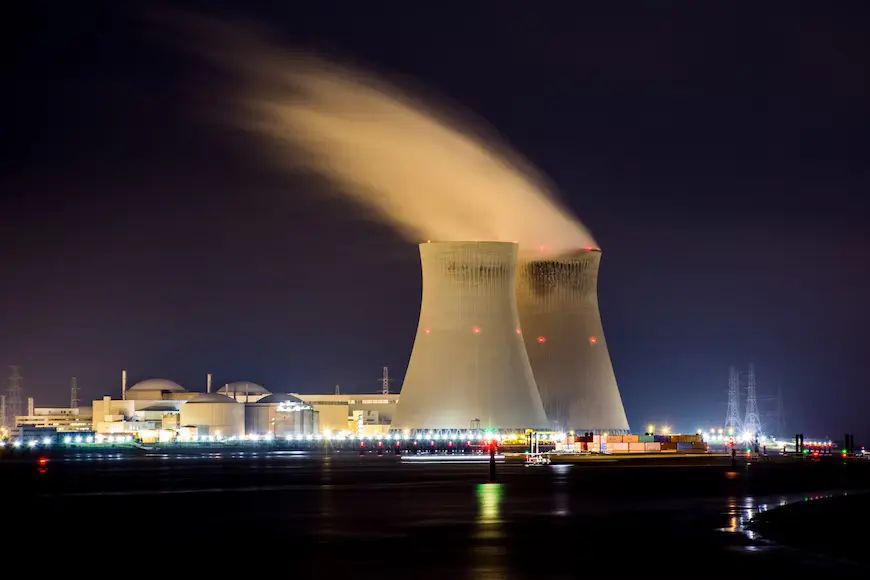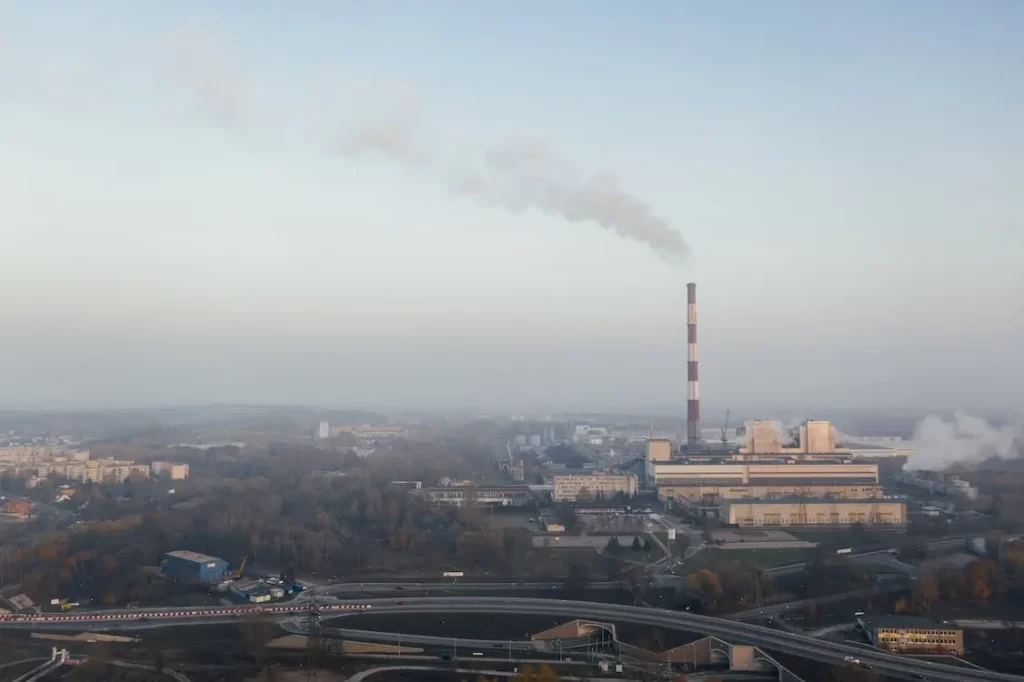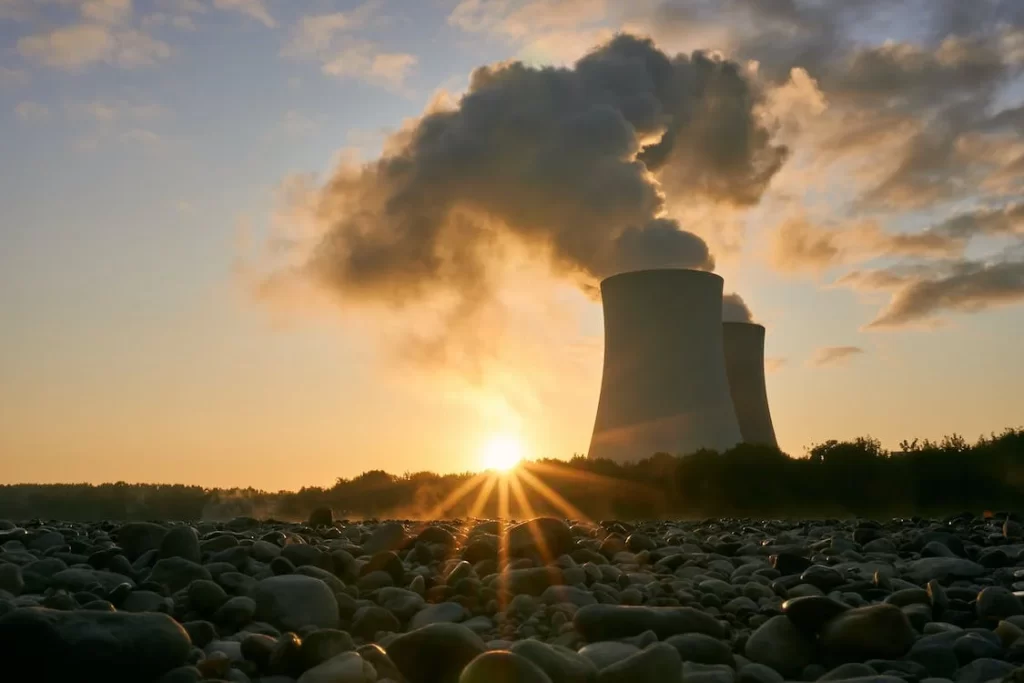Do you know where your electricity comes from? For 19% of the United States, it comes from nuclear power plants.
Trendy solar panels and wind turbines overshadow the popularity of nuclear energy, a clean power technology that has been around for over 70 years.
Nuclear energy has a stigma that is tough to shake. The Simpsons popularized the image of barrels of green glowing radioactive goo – an image that’s far from the truth.
Many people remember the accidents at Chernobyl and Three Mile Island, and the recent Fukushima accident rekindled fears of a major nuclear accident.
While people may not be talking about it much, other countries see the advantages of nuclear energy. China, for instance, now has 53 nuclear power reactors with 6 more on the way.
This is a major part of China’s bid to become energy independent – reducing reliance on coal and clearing the air from the pollution caused by burning fossil fuels.
Let’s explore 10 advantages of nuclear energy that make it a good way forward in our efforts to stop climate change and decrease our dependence on fossil fuels.
10 Advantages of Nuclear Energy
- Nuclear Power is Carbon-Free
- Nuclear Power is Cleaner than Fossil Fuels
- Nuclear Power Plants Provide Recreation
- Nuclear Reactors are Safe
- Nuclear Fuel is Abundant
- Nuclear Energy is Reliable
- Nuclear Fuel is Dense
- Spent Fuel is Easy to Store
- Nuclear Energy is Inexpensive
- Nuclear Energy is Efficient
Read on to see why each of these things make nuclear power an advantage for nations that harness its energy.
10 Advantages of Nuclear Power
1. Nuclear Power is Carbon-Free

Nuclear power saves 470 million metric tons of carbon dioxide per year from going into the atmosphere compared to if we burned fossil fuels to generate that electricity.
That’s because nuclear power burns perfectly clean. There are zero carbon emissions from a nuclear power plant.
The clouds coming from the giant cooling towers are clean water vapor, not smoke or any type of pollution. It’s just water.
Is Nuclear Energy Renewable?
While nuclear power requires the use of non-renewable natural resources – uranium – it produces a massive amount of power from a tiny amount of fuel and it does so without any carbon or pollution.
The worldwide uranium reserves are estimated to last for the next 90 years or so. In the meantime, new technology aims to ensure that we can use clean nuclear energy far into the future.
- Accident Tolerant Fuel is being developed that will tolerate fluctuating conditions inside a reactor without melting down.
- Several National Laboratories are developing methods to recycle spent uranium fuel because it still has around 90% of its energy left even after 5-6 years in a reactor.
- New reactors are in development and set to roll out soon that are designed to use “spent” fuel rods.
- New reactors are in development that will use plutonium instead of uranium.
- Some of the new reactors can also be used to produce hydrogen – a clean-burning fuel that can be derived from water.
One of the nuclear energy pros is that while it’s not renewable, it does have a lot of energy left even while it sits in storage. The goal is to be able to recover that material and use it.
Does Nuclear Power Generate Greenhouse Gas Emissions?

Not when it is in the reactor. During electricity generation, the process is completely clean.
However, the construction of a nuclear plant requires fossil fuels. Manufacturing of steel and cement carries with it a carbon footprint.
There is also a pollution issue with storing spent fuel rods while they await their future. There is fossil fuel burned during mining and transportation of the raw material and as it goes into storage.
The fact is that nuclear energy pros and cons have to be part of the overall discussion, though the pros realistically outweigh the cons.
Nuclear power is extremely competitive with other climate-friendly energy sources.
According to the U.S. Department of Energy’s National Renewable Energy Laboratory, a nuclear power plant will produce about 12 grams of CO2-equivalent per kilowatt-hour of electricity produced.
That level is similar to wind turbines and less than photovoltaic cells that collect solar power.
2. Nuclear Power is Cleaner Than Fossil Fuels
Burning coal is just about the worst thing we can do for our air quality besides going back to burning timber 24/7.
Coal-fired power plants spew a wide range of unhealthy chemicals into the air, including sulfur dioxide, nitrogen oxides, mercury, particulate matter, and other pollutants.
Increasing national nuclear energy output would mean that electric cars would run on a clean power source.
This is one of the major nuclear energy pros, especially as states begin banning gasoline cars.
When you plug your electric vehicle into the grid you are pulling a mere fraction of electricity from clean energy sources to charge your car.
The rest of the electricity is from coal and other fossil fuels. This makes your EV have similar air quality impacts compared to gasoline, it’s just belching out of a smokestack instead of your tailpipe.
The construction of nuclear plants, the production of fuel, and the transport of waste do produce some air pollutants.
However, nuclear power does not impact air quality, and overall, nuclear power provides a much cleaner source of energy compared to fossil fuels.
Operating nuclear power plants is as clean as running the equivalent in wind turbines – an unreliable and expensive power source.
3. Nuclear Power Plants Provide Recreation

Nuclear plants require water reservoirs, and these lakes can double as recreational areas for the public.
Reservoirs often provide opportunities for boating and fishing, and local governments have established parks along the shores of these lakes.
Providing recreation opportunities near the power plants can help ease public concerns about safety. Trust in technology sometimes requires an up close and personal experience.
Cooling towers rising above the trees at a park may seem ominous at first, and some think they’re pollutive, but they’re not. They are producing clean, reliable energy for the community.
The water reservoirs used in nuclear power plants are not in any way contaminated. They’re used to run massive electricity generation turbines.
The nuclear reactor heats water which turns into steam. The steam rises and powers turbines then cools down again and returns to the water source.
The water never comes in contact with radioactive materials.
4. Nuclear Reactors are Safe
Safety standards and technology continue to reduce the risk of accidents at nuclear power plants.
The International Atomic Energy Agency produced a scale that measures the severity of nuclear accidents – The International Nuclear Events Scale (INES).
- The most severe accident on the INES is a level 7, and there’s only been one of these, ever. You guessed it, that was the Chernobyl meltdown in 1986 in Ukraine.
The most severe accident in the U.S. was Three Mile Island in 1979, which was a Level 5. The most recent accident globally was Fukushima – also a Level 5.
Many fear that nuclear plants will become more dangerous. Others believe that nuclear power is polluting the air. Both of these fears are based on a false premise.
The fact is that nuclear energy becomes safer as new power plants are built and new fuel rod designs are put in place.
America should be focusing more on upgrading our safe nuclear energy sources because when we do we’re also investing in energy independence.
5. Nuclear Fuel is Abundant

The supply of nuclear fuel is a moving target. The amount of known, readily-available uranium ore will last about 90 years.
However, there are unconventional sources of uranium with yields we don’t know about, such as oceanic areas.
There are also other radioactive ores like plutonium that can be used, and technology is currently being developed to use it.
Reenrichment of spent uranium will increase our uranium supply by many decades, as will the development of plants that harvest energy from lower-quality blends.
Is Nuclear Power Better than Solar Power?

In a lot of ways, yes it is.
- One of the advantages of nuclear energy is it is overall less pollutive than building and installing solar panels.
- A nuclear plant will last for many decades, whereas a solar panel will last maybe 20 years
- Solar panels also have toxic waste in them like lead and mercury. Nuclear waste and solar waste require safe disposal.
- Nuclear waste can be recycled into new fuel. Solar panels cannot.
- Nuclear plants are extremely efficient and reliable. Solar energy collection can be difficult due to weather and sundown.
Having said that, we have a non-renewable fuel source for nuclear. The sun is our most reliable fuel source, even though it can be hit-or-miss for collecting its rays.
Also, both options are far better than burning fossil fuels for energy.
Read More: Is Carbon Sequestration Effective? Learn what it is and if it could be an effective solution to combat global warming.
Is Nuclear Power Better than Wind Energy?

This is a bit of a toss-up and each type of energy wins in a different way.
- Wind turbines only operate at 20% to 40% efficiency over their lifespan of about 20 years. Nuclear plants crank out maximum power for up to 40 years.
- Wind turbines create a lot of landfill waste, but spent nuclear rods need water storage and then dry cask storage facilities.
- Wind turbines and nuclear plants have right about the same amount of carbon output over their lifespan.
Wind is a great source of energy when its blowing, but it is too unreliable to be a sole source of electricity.
Nuclear is incredibly reliable, so it’s an ideal clean energy source to use, especially since we’re still in the process of developing clean energy solutions that can realistically meet our national energy needs.
6. Nuclear Energy is Reliable
Nuclear power plants provide our most reliable electricity feed that’s not based on fossil fuels.
While we try to decrease our dependence on coal and oil for energy production we need to have a better alternative than simply switching to alternative energy sources that often fail.
Nuclear represents our best mid-term option for clean energy. It is our most realistic tool to help us reverse global warming while we wrestle with developing the tech to efficiently harvest sun, wind, and wave energy.
7. Nuclear Fuel is Dense
Would you believe that all of the uranium used since 1951 would fit inside a football field?
A lot of the arguments against nuclear power paint pictures of the United States swimming in nuclear waste, but this isn’t true.
That’s because we tend to compare a ton of coal to a ton of uranium as if we were comparing apples to apples, but we’re not.
A pound of uranium makes a ball that’s 1.3 inches in diameter. That’s so small!
Uranium ore is processed and stabilized in small ceramic pellets about the size of the end of your thumb.
Every single pellet produces the same amount of energy as burning a full ton of coal.
We know the greenhouse gas emissions from burning coal. All of this can be offset with a single uranium pellet.
8. Spent Fuel is Easy to Store

There are 80 nuclear storage facilities spread all around the United States. 57 of these sites are currently operating 96 nuclear power reactors.
Most people have no idea that there is a nuclear waste disposal storage facility close by.
When uranium is enriched for power production it is stabilized in small ceramic pellets about the size of a thimble.
They’re then placed inside sealed metal rods that are about 12 feet long. These rods are bundled together and placed into the reactor core to heat water as part of the electricity generation process.
The spent fuel is never separated from its protective sleeve. It stays sealed inside the original container in storage.
Some storage facilities have giant pools of water. The fuel rods are placed in this water to cool for about 10 to 12 years. There is a full staff that monitors and controls this cooling process 24/7.
Once the fuel is cool it can be stored in dry casks.
Even this storage process is very clean. Aside from burning fossil fuels to transport the rods, the fuel rods don’t generate any greenhouse gases during their lifetime.
9. Nuclear Energy is Inexpensive
Nuclear energy is one of the most affordable types of energy we have that’s widely available.
It costs between 6 and 9 billion dollars to construct a nuclear power plant. This is significantly higher than constructing a coal, oil, or natural gas plant. This is due to the safety features needed.
However, once the plant is operational it uses a relatively cheap fuel. At the time of publication, Uranium was trading at roughly $52 per pound.
Due to the emerging European energy crisis, coal has skyrocketed to $430 per ton. Keep in mind that a single pellet of uranium produces the same energy as a full ton of coal.
The cost of uranium fluctuates, but not nearly to the extent of coal and oil.
10. Nuclear Energy is Efficient
This is related to the fuel density of uranium and the efficiency of power generation plants.
New nuclear plants are much more efficient than older ones, but the average efficiency is still about 91% compared to coal at 59% efficient.
This refers to the amount of energy harvested from the material. A lot of fuel energy is lost in heat, and some is burned off, especially at oil and coal plants.
This efficiency is often referred to as “energy density.” That is a way to describe the amount of energy produced by a small amount of material.
The energy density of a nuclear fission power plant is roughly 8,000 times higher than a fossil fuel plant. That’s a huge difference.
Economic Advantages of Nuclear Energy

One of the clearest economic advantages is felt in communities that host nuclear power plants.
- Communities enjoy affordable, reliable power in their homes and businesses.
- Nuclear plants employ up to 700 workers per plant compared to a max of 200 workers in a coal plant.
- Nuclear plant workers enjoy salaries about 30% higher than other energy sector employees.
- The economic windfall affects all the other businesses in the surrounding area that enjoy extra spending and additional job opportunities.
Nuclear power plants support businesses and industries on all levels with clean, reliable power that helps to provide an additional $60 billion in GDP to the US economy.
Environmental Advantages of Nuclear Energy
There are some cons to nuclear energy – the biggest one being environmental disruption from uranium mining.
However, even this environmental disruption is so much less than the interruption from coal mining. Add to this the much higher health risks of coal mining, and uranium mining is preferential.
The environmental advantages of nuclear energy are vast in spite of the need for a uranium supply.
- The total carbon footprint of a nuclear power plant is about the same as a wind farm of the same output.
- Nuclear power plants don’t contaminate local water supplies like coal and biomass plants do.
- Nuclear plants don’t contaminate the air like coal, gas, and biomass plants do.
- The “smoke” from the cooling towers at a nuclear plant is clean steam.
- Nuclear power plants produce zero greenhouse gas emissions during power generation.
- The amount of fuel needed to power a nuclear plant is minuscule compared to the many tons of coal and barrels of oil burned daily to achieve the same output.
- Nuclear power plants don’t cause deforestation like biomass power plants do.
Nuclear power is safe, clean, and reliable. It’s safe for humans to be around, unlike fossil fuel plants, and it doesn’t contaminate the environment.
The amount of nuclear waste generated from a plant is so tiny compared to the ash and waste from fossil fuel and biomass plants.
As new technology is put in place to recycle spent nuclear rods, nuclear power will become the cleanest type of energy we have.
Why Isn’t Nuclear Power Everywhere?

So why doesn’t every community have a nuclear power plant? Well, nuclear power plants come with a hefty price tag.
Countries with strict regulations also require a long permitting process. All part of the improved safety net, of course. Something we wouldn’t want to skip over.
Public perceptions play a role, and trust in the technology has been limited given the accidents that have occurred within the past 30 years.
Improved technology and continual improvements are helping to improve safety and ease fears.
In reality, the industry has grown to support 437 nuclear reactors around the world. Developing countries are seeing nuclear power as a way to provide reliable, self-sustaining energy.
Final Thoughts
While there are pros and cons of nuclear energy, one of the most convincing nuclear energy pros is that it’s our best option for stabilizing the earth’s atmosphere while providing the electricity we need.
We can’t just keep burning coal and oil while we wait for better development of green energy.
Green energy sources still aren’t very efficient and our energy demands are quickly outgrowing even the most ambitious green energy programs.
In the meantime, nuclear power is our best option.
What do you think about nuclear energy? Let us know in the comments below!
